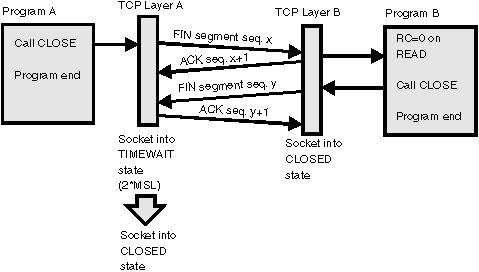 z/OS Communications Server: IP Sockets Application Programming Interface Guide and Reference
z/OS Communications Server: IP Sockets Application Programming Interface Guide and Reference
 z/OS Communications Server: IP Sockets Application Programming Interface Guide and Reference
z/OS Communications Server: IP Sockets Application Programming Interface Guide and Reference
|
Previous topic |
Next topic |
Contents |
Contact z/OS |
Library |
PDF
Active and passive closing in an iterative server program z/OS Communications Server: IP Sockets Application Programming Interface Guide and Reference SC27-3660-00 |
|
|
The program that initiates the closedown process by issuing the first close() call is said to initiate an active close. The program that closes in response to the initiation is said to initiate a passive close. Figure 1 illustrates socket closing. Figure 1. Closing sockets
 In Figure 1, Program A initiates the active close, while Program B initiates the passive close. When a program calls the close socket function, the TCP protocol layer sends a segment known as FIN (FINish). When Program B receives the final acknowledgment segment, it knows that all data has been successfully transferred and that Program A has received and processed the FIN segment. The TCP protocol layer for Program B can then safely remove the resources that were occupied by the Program socket. The TCP protocol layer for Program A sends an acknowledgment to the FIN segment it received from Program B, but the Program A TCP protocol layer does not know whether that ACK segment arrived at the Program B TCP protocol layer. It must wait a reasonable amount of time to see whether the FIN segment from Program B is retransmitted, indicating that Program B never received the final ACK segment from Program A. In that case, Program A must be able to retransmit the final ACK segment. The Program A socket cannot be freed until this time period has elapsed. The time period is defined as twice the maximum segment life time, normally in the range of 1 to 4 minutes, depending on the TCP implementation. If Program A is the client in a TCP connection, this TIMEWAIT state does not create any major problems. A client normally uses an ephemeral port number; if the client restarts before the TIMEWAIT period has elapsed, it is merely assigned another ephemeral port number. If Program A, on the other hand, is the server in a TCP connection, this TIMEWAIT state does create a problem. A server binds its socket to a predefined port number; if the server tries to restart and bind the same port number before the TIMEWAIT period has elapsed, it receives an EADDRINUSE error code on the bind() call. This situation could arise when a server crashes and you try to restart it before the TIMEWAIT period has elapsed. You must wait to restart your server. If the server cannot wait for one to four minutes, you can use the setsockopt() call in the server to specify SO_REUSEADDR before it issues the bind() call. In that case, the server will be able to bind its socket to the same port number it was using before, even if the TIMEWAIT period has not elapsed. However, the TCP protocol layer still prevents it from establishing a connection to the same partner socket address. As clients normally initiate connections and clients use ephemeral port numbers, the likelihood of this is low. 


|
 Copyright IBM Corporation 1990, 2014 Copyright IBM Corporation 1990, 2014 |